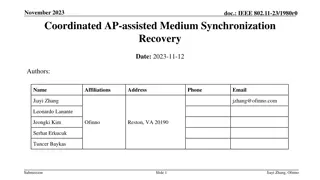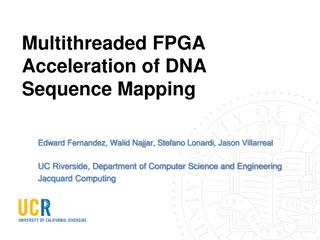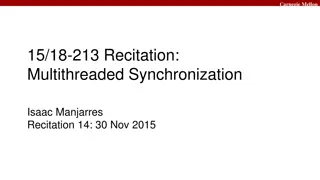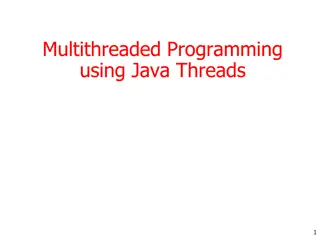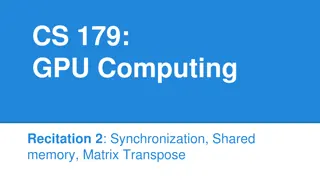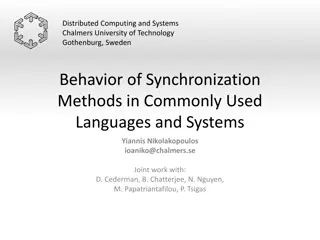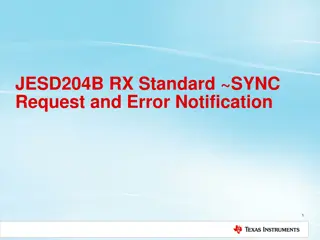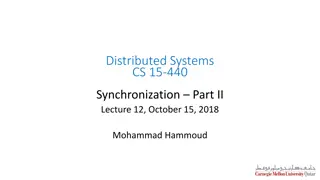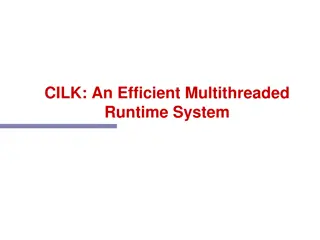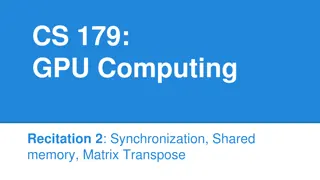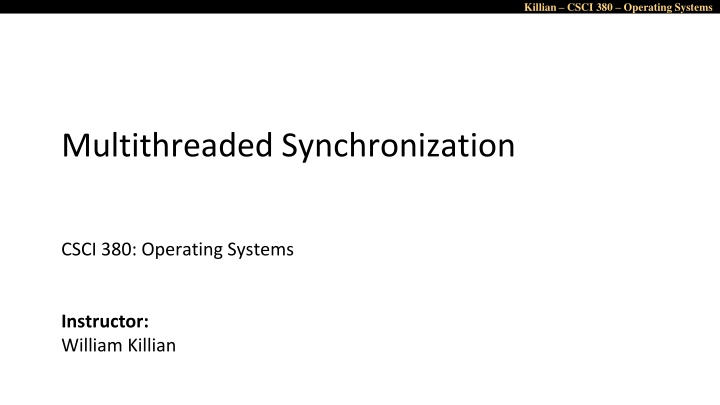
Operating Systems Multithreaded Synchronization
Explore the concepts of multithreaded synchronization in operating systems with examples of proxy server code, debugging tools, and the complexities of shared memory and critical sections. Delve into handling requests sequentially, identifying weaknesses in server approaches, and advanced debugging techniques using telnet, curl, and web protocols.
Download Presentation

Please find below an Image/Link to download the presentation.
The content on the website is provided AS IS for your information and personal use only. It may not be sold, licensed, or shared on other websites without obtaining consent from the author. If you encounter any issues during the download, it is possible that the publisher has removed the file from their server.
You are allowed to download the files provided on this website for personal or commercial use, subject to the condition that they are used lawfully. All files are the property of their respective owners.
The content on the website is provided AS IS for your information and personal use only. It may not be sold, licensed, or shared on other websites without obtaining consent from the author.
E N D
Presentation Transcript
Killian CSCI 380 Operating Systems Multithreaded Synchronization CSCI 380: Operating Systems Instructor: William Killian
Killian CSCI 380 Operating Systems Agenda Proxy Server Basic server code examples Debugging tools Concurrency The Good, The Bad, and The Ugly Shared Memory: Synchronization Critical Sections and Locking Common bugs
Killian CSCI 380 Operating Systems The Echo Server Sequential Handling void echo(int connfd) { size_t n; char buf[MAXLINE]; rio_t rio; // initialize robust io for reading on file descriptor Rio_readinitb(&rio, connfd); while((n = Rio_readlineb(&rio, buf, MAXLINE)) != 0) { printf("server received %d bytes\n", (int)n); // read to buffer, and write it back Rio_writen(connfd, buf, n); } }
Killian CSCI 380 Operating Systems The Echo Server Sequential Handling int main(int argc, char **argv) { int listenfd, connfd; struct sockaddr_storage clientaddr; socklen_t clientlen; char client_hostname[MAXLINE]; client_port[MAXLINE]; listenfd = Open_listenfd(argv[1]); while(1) { // Handle requests one at a time. I hope I m not popular! clientlen = sizeof(struct sockaddr_storage); // Important! connfd = Accept(listenfd, (SA*)&clientaddr, &clientlen); Getnameinfo((SA*)&clientaddr, clientlen, client_hostname, MAXLINE, client_port, MAXLINE, 0); echo(connfd); Close(connfd); } assert(0); }
Killian CSCI 380 Operating Systems The Echo Server: Finding Its Weakness Using telnet, we can observe a weakpoint within this iterative approach. telnet localhost 15213 telnet localhost 15213 ./echo 15213 The second client cannot connect, because echo has not yet closed its connection with the first client.
Killian CSCI 380 Operating Systems More Advanced Debugging Telnet requires you to type everything yourself Web protocols (like HTTP) can be tedious to type Use curl to form requests for you curl --proxy http://localhost:port url.com Redirect output using >, for non-text files Don t forget that binary data is not the same as text data Be careful when using functions that are meant to operate only on strings. They will not work properly with binary data
Killian CSCI 380 Operating Systems How Threads Work: Nuances Threads run within the same process context Arbitrary interleaving and parallelization similar to processes from Shell Lab But keep in mind they are separate logical flows, not separate processes This implies that there are still context switches, much like with processes, but they are of less duration since threads have less context to store away than processes
Killian CSCI 380 Operating Systems Critical Points for Threads Threads have their own: Thread ID Stack(contained within the stack area for that process) Stack Pointer Instruction Pointer General Purpose Registers Status Codes Threads share: Code sections Heap Open files
Killian CSCI 380 Operating Systems Anatomy of pthread_create Pointer to a variable that will hold the new thread s ID Threads created with pthread_create: int pthread_create(pthread_t *threadID, const pthread_attr_t *attr, void *(*start_routine)(void *), void *arg); NULL for this course Pointer to a function that takes in a void pointer, and returns a void pointer. This function is what the new thread will execute. Pointer to an argument for the function that the thread will execute. Can pass Multiple arguments by putting them in a struct and passing a pointer to the struct
Killian CSCI 380 Operating Systems Working Together: When to use Threads Let s sum up the elements in an array. The boring way: int sum = 0; for (int i = 0; i < n; i++) sum += nums[i];
Killian CSCI 380 Operating Systems Sums: The Fun Way void *thread_fun(void *vargp) { int myid = *((int *)vargp); size_t start = myid * nelems_per_thread; size_t end = start + nelems_per_thread; size_t i; size_t index = myid*spacing; data_t sum = 0; for (i = start; i < end; i++) // sum our section sum += i; psum[index] = sum; return NULL; }
Killian CSCI 380 Operating Systems Sums: The Fun Way nelems_per_thread = nelems / nthreads; // Create threads and wait for them to finish for (i = 0; i < nthreads; i++) { myid[i] = i; Pthread_create(&tid[i], NULL, thread_fun, &myid[i]); } for (i = 0; i < nthreads; i++) Pthread_join(tid[i], NULL);
Killian CSCI 380 Operating Systems Sums: The Fun Way result = 0; // Add up the partial sums computed by each thread for (i = 0; i < nthreads; i++) result += psum[i*spacing]; // Add leftover elements for (e = nthreads * nelems_per_thread; e < nelems; e++) result += e; return result;
Killian CSCI 380 Operating Systems Advantages & Disadvantages Good: We can (potentially) make it faster We can exploit better use of the cache Bad: Hard to write! Shared resources difficult to manage Here, we provide mutual exclusion by going to different sections of the array between threads, but we can t always do this.
Killian CSCI 380 Operating Systems Critical Sections and Shared Variables Let s try some more counting with threads. volatile int total = 0; void incr(void *ptr) { pthread_detach(pthread_self()); for (int i = 0; i < *ptr; i++) total++; }
Killian CSCI 380 Operating Systems Critical Sections and Shared Variables #define NTHREADS 2 #define NINCR 100 int main() { pthread_t tids[NTHREADS]; int y = NINCR; for (int i = 0; i < NTHREADS; i++) pthread_create(&tids[i], NULL, incr, &y); // output will range between NTHREADS-y*NTHREADS printf( total is: %d , total); }
Killian CSCI 380 Operating Systems What happens 1 0 2 1 1 2 3 total 2 2 thread 1 thread 2
Killian CSCI 380 Operating Systems Mutexes Solution: Lock/suspend execution of thread until resource is acquired volatile int total = 0; pthread_mutex_t M; void incr(void *ptr) { pthread_detach(pthread_self()); for (int i = 0; i < *ptr; i++) { pthread_mutex_lock(&M); total++; // CRITICAL SECTION pthread_mutex_unlock(&M); } }
Killian CSCI 380 Operating Systems Mutexes Remember to initialize the mutex first! #define NTHREADS 2 #define NINCR 100 volatile int total = 0; pthread_mutex_t M; ... int main() { ... pthread_mutex_init(&M); ... }
Killian CSCI 380 Operating Systems Semaphores and Atomicity A semaphore is a special counter with an invariant Let s represent some semaphore, and T be the time domain Invariant: At any given time, the value of a semaphore is non-negative (i.e. ? ?.??? ? 0) Mutexes are a subclass of semaphores in the sense that they either have a value of 0 or 1 P(s) operation locks a resource (by decrementing the value of s) such that when another thread tries to lock the resource by calling P(s), the value may be 0, and that thread will be suspended until the value of s is greater than 0 V(s) operation frees a resource (by incrementing the value of s) such that when it is called, s now has a value greater than 0, and any thread that may have been asleep as a result of waiting for s to be free can now be woken up Atomic Operation-An operation that is not interrupted once it has begun executing P and V operations are atomic
Killian CSCI 380 Operating Systems Problem solved right? Locks in threads are slow This is a terrible way to sum up to 200 Avoid shared memory if you can This is one of the simpler models for thread sync. Reading vs. Writing Producers and Consumers
Killian CSCI 380 Operating Systems Synchronization Gone Wrong Part 1
Killian CSCI 380 Operating Systems Synchronization Gone Wrong Part 2 What s wrong with this? Note how there is only a small fraction of time per thread where calculations are actually being done The great majority of the time is spent waiting to execute calculations again This is a waste of valuable processor time Do not do this Solution Write code that will minimize the amount of time that the processor is not doing anything useful
Killian CSCI 380 Operating Systems Readers and Writers writer cache reader reader reader reader
Killian CSCI 380 Operating Systems Readers and Writers :( writer cache reader reader reader reader
Killian CSCI 380 Operating Systems Readers and Writers writer cache reader reader reader reader
Killian CSCI 380 Operating Systems Readers and Writers writer cache reader :( reader reader reader
Killian CSCI 380 Operating Systems Readers and Writers writer cache reader reader reader reader
Killian CSCI 380 Operating Systems Concurrency and Starvation In previous example, readers block one writer Writer might not get the resource Writer is being starved of resource Make sure that readers don t hold resource for long
Killian CSCI 380 Operating Systems Problem: Deadlock I ll give you x if you give me y. I ll give you y if you give me x. Well, that s awkward. Thread 1 Thread 2
Killian CSCI 380 Operating Systems Problem: Deadlock Entire program will hang Pay attention to how and where you lock/unlock Program may or may not hang predictably Thread scheduling is non-deterministic Similar to race conditions, usually worse Critical section should be as small as possible
Killian CSCI 380 Operating Systems Problem: Livelock Similar to Deadlock Two programs feed back on one another Spins indefinitely instead of hanging Two people trying to get past each other in a hallway Both move the same direction simultaneously Both do an awkward dance from side to side Dance continues indefinitely Often happens when threads attempt to compensate for deadlock
Killian CSCI 380 Operating Systems Recognitions Slides adapted from Jack Biggs


